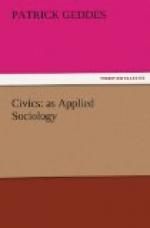The philosopher of old in his academic grove, his porch, the mediaeval monk within his studious cloister’s pale, are thus more akin to the modern scientific thinker than he commonly realises—perhaps because he is still, for the most part, of the solitary individualism of the hermit of the Thebaid, of Diogenes in his tub. Assuredly, they are less removed in essential psychology than their derived fraternities, their [Page: 85] respective novices and scholars, have often thought. It is thus no mere play of language which hands on from the one to the other the “travail de Benedictin,” though even here the phrase is inadequate savouring too much of the school, into which each cloister of every sort declines sooner or later, unless even worse befall.
The decay of the cloister, though thus on the one hand into and with the school, may also take place within itself, since imagination and ideal may be evil, and theory false. That examples of all these decays abound in the history of religion, of philosophy, of art also, is a commonplace needing no illustration. Nor should the modern investigator think his science or himself immune to the same or kindred germs in turn.
K—THE CITY PROPER
Now, “at long last,” we are ready to enter the city proper. This is not merely the Town of place and work and folk, even were this at their economic best. It is not enough to add the School, even at its completest; nor the cloister, though with this a yet greater step towards the city proper is made. For though this is not itself the City, its ideals of human relations, its theory of the universe and man, its artistic expression and portrayal of all these, ever sooner or later react upon the general view and conduct of life. Hence the Academe of Plato and the Lyceum of Aristotle, the mediaeval cloister and the modern Research Institute, have been so fertile, so creative in their influence upon the city’s life, from which they seemed to be retired. Hence




